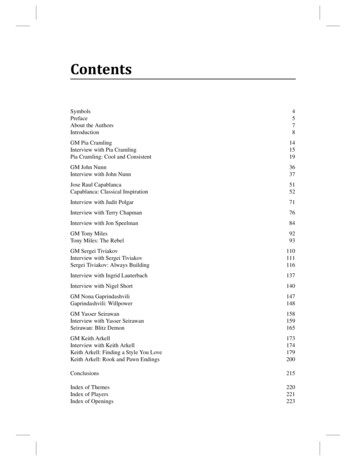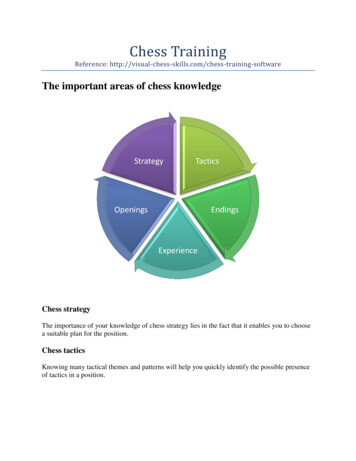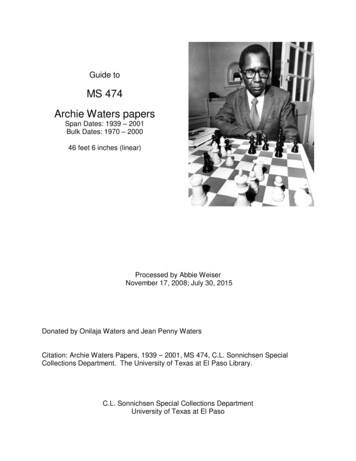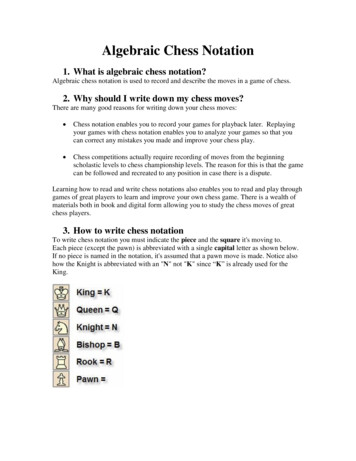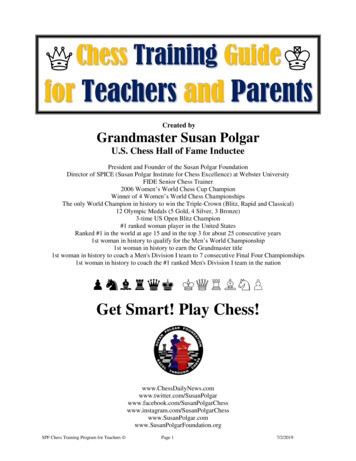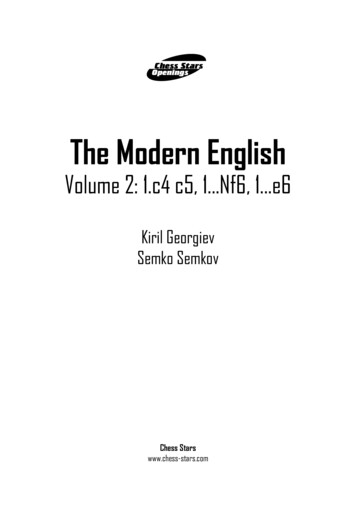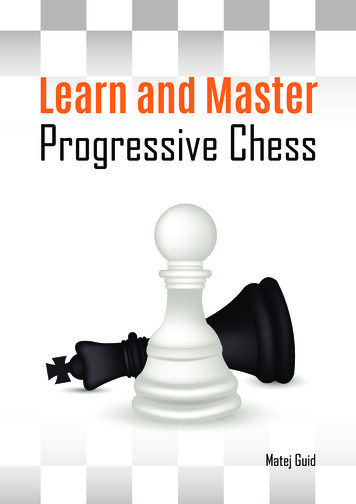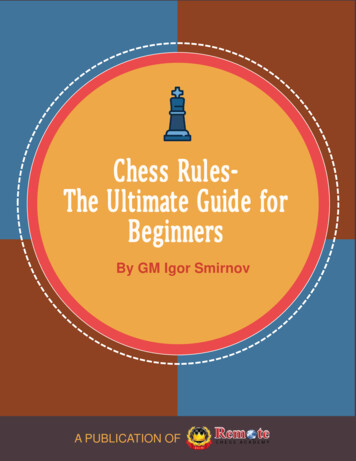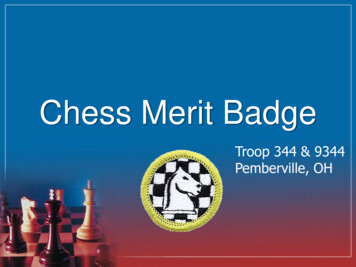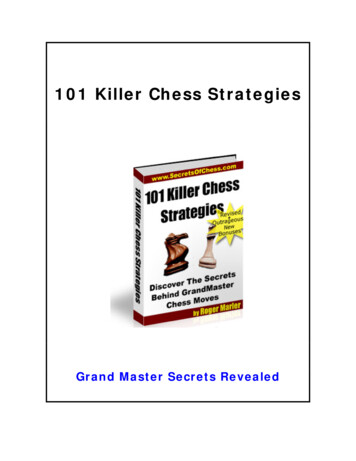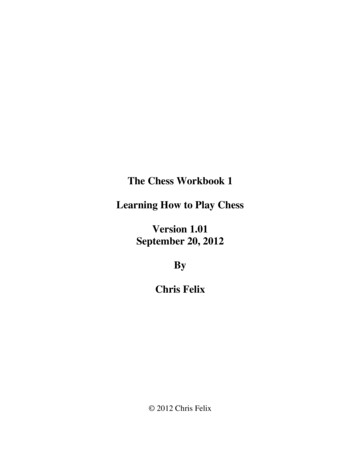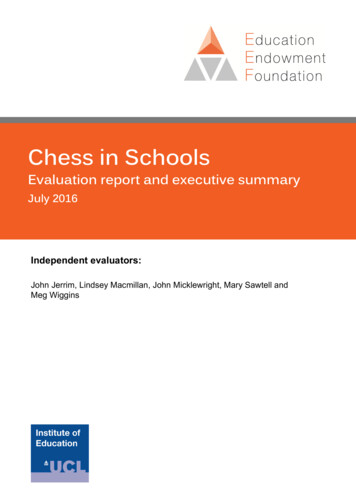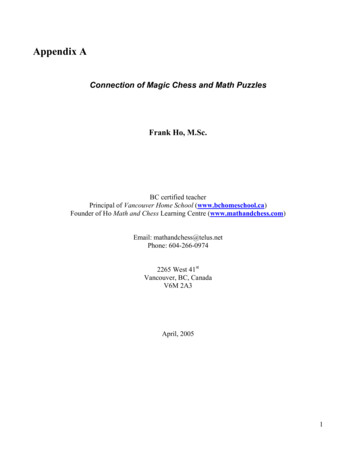
Transcription
Appendix AConnection of Magic Chess and Math PuzzlesFrank Ho, M.Sc.BC certified teacherPrincipal of Vancouver Home School (www.bchomeschool.ca)Founder of Ho Math and Chess Learning Centre (www.mathandchess.com)Email: mathandchess@telus.netPhone: 604-266-09742265 West 41stVancouver, BC, CanadaV6M 2A3April, 20051
AbstractMagic Chess and Math Puzzles workbook is a new idea of learning chess and also enriching mathproblem-solving ability using creative minds of hands-on, multi-concept, multi-direction, multioperation, multi-sensory and visual learning.Hands-onChess provides ample hands-on opportunities. One has to physically move chess pieces to get gamegoing.Multi-conceptMath puzzles worksheets are designed to learn division while doing multiplication and learningsubtraction while doing addition.Multi-directionChess is a multi-direction game. Some worksheets are deigned in a way that the operation is no lonerjust a linear fashion from left to the right. The direction could be from bottom to top, from left to right,and also diagonally or even crossed.Multi-sensoryThe learning of chess involves eye, hands, and brain coordination. The math pattern puzzle trainsvisualization.This paper provides information on why using Magic Chess and Math Puzzles would improve astudent’s math problem-solving ability. The information is provided by extracting smaple problemsfrom the workbook and then gives a corresponding math concept learned by doing the sampleproblems.This one- on- one table style comparison gives concrete evidence on what math concepts are learnedafter working on the math puzzles that are included in the workbook.2
BackgroundI started to teach my son Andrew chess when he was five years old. A lot of information I have readindicates that there is a strong relationship between mathematics and chess. My son was interested inchess so what would happen if he carried the same interest in chess on to a subject which would requirehim to use his chess knowledge? What could chess offer in mathematics education? These kinds ofquestions sparked my interest in study the relationship between chess and math. What I had found wasthere have been many chess or math puzzles published but I was not able to find a collection ofmathematical chess problems that was specifically created for youngsters.In 1995, I was involved in teaching math and chess at the same time and I started to seriously look intothe possibility of creating some math and chess hybrid problems. This is how Andrew and I started tocreate the first generation of Math and Chess integrated workbook entitled Mathematical Chess Puzzlesfor Juniors (ISBN 0-9683967-0-4 and is archived at National Library of Canada). It is designed andwritten for the purpose of learning all kinds of problem-solving skills through over 100 mind provokingand sometimes mind boggling mathematical chess puzzles. The uniqueness of this book is that only thebasic chess knowledge and the elementary math ability are needed to solve most of these puzzles.I have been working on refining the contents ever since and after 10 years of working on the workbook,it has incorporated many math concepts and today’s version is the third generation. The workbookcould be used as a supplemental or enriched material to supplement math curriculum.World’s first claim and copyrightI made the claim that the first edition of workbook Mathematical Chess Puzzles for Juniors created in1995 was a world’s first. I did a through literature and library catalogues searches and publicized myworkbook on the internet (including rec.games.chess.misc) resulted in nothing. There was no integratedchess and math workbook ever published commercially for the elementary students at the time when Ipublished my workbook in 1995. In addition, I have updated the workbook since I published the firstone 10 years ago with many new and innovative ideas, no one has ever done or created such aworkbook. It would be devastating for me if some copycat just copied my ideas and formats ofworksheets and started to commercialize it. To protect my intellectual property, I lay claims as beingthe world’s first on the following ideas and concepts and the original creator of unique formats ofworksheets:3
1995, I incorporated the values of chess pieces into math (The value system is the one used byChess Federation of Canada.).July, 2004, I created two-column format, one column is chess question and the other side ismath puzzles, which show the logic relationship between chess and math. This is the secondgeneration version.February, 2005, I used chess figures in the math puzzles to instil the concept of variables. Thisis the third generation of workbook.I found that in real life, students do not just learn four operations ( ) in a sequential manner, forexample, when a child taking one apple out of four apples, it is an operation of addition (getting oneapple) but also a subtraction (3 apples left). I thought it would be a good idea that students could learnmulti-operation and multi-concept at the same time to reflect the real life experience. Many mathpuzzles worksheets were converted from my math worksheets originated by me.All problems and worksheet formats presented in this article are originally created by Frank Ho, so nopart of these worksheets formats or problems may be reproduced without the written permission ofFrank Ho.4
How math and chess were integratedThe updated workbook today is called Magic Chess and Math Puzzles to reflect the magic relationshipof mathematics and chess and how chess could be used in improving mathematics ability.I did not want to create a workbook, which is just a collection of chess puzzles, nor I wanted to create aworkbook, which was a collection of brain teasing math puzzles. The problems in my workbook Ienvisioned to create must have the following characteristics:1.2.3.4.5.Must have some logic connection between chess and math problems.Students could learn chess and improve math ability at the same time.Problems created must be innovative and interesting.Only basic chess is required to solve the math problems.Elementary students from grade 1 and above could solve these problems.With the above requirements in mind I was searching the logic and mathematical connection betweenmath and chess and the result is many of these problems were created using chess positions and are notsuitable for elementary students.In 1995, the breakthrough came to me when I realized that I could use the relative value of chess piecesto create mathematical chess puzzles. I have since created many of these types of problems and Ibelieve this idea of using relative chess piece values to create mathematical chess puzzles is world’sfirst.In July, 2004, I started to use two-column system to place chess questions on one-side and mathproblems on the other side to show the possible logic relationship between chess and math. At the sametime I was creating math worksheets for elementary students. Some of these math worksheets formatswere created by me and they are very unique, I incorporated some of these unique math worksheetsinto my chess workbook.In February, 2005, the third generation of Magic Chess and Math Puzzles was born. I incorporatedchess figures into mathematical equation and the result was a big surprise to me since to some childrenthe learning of using these chess variables in the equations seems to be so natural to them, they are notrealizing that they are actually learning algebra at grade 3. At this point I decided to change myworkbook name Chess and Mathematical Chess Puzzles to Magic Chess and Math Puzzles to betterreflect the intriguing and magic relationship between chess and math.5
Learning expectationsPeople always wonder what exactly is the relationship between chess and math and how much mathconcepts in my workbook are children learning? What are the expected learning outcomes? Myworkbook is not designed to prepare children for the chess tournament, not is it written to prepare formath contest. It is designed to lead children into the wonder world of learning chess and at the sametime to introduce some math concepts using chess as a learning tool. It is written with the idea to showchildren that math is not just doing drill and boring math computations day in and day out. It is offeredas an alternative and supplemental learning resources for math education but not to replace school mathcurriculum. The expected chess-learning outcome stops at the tactics level and could be easily seenfrom the table of contents of the workbook.In this article, I would like to give some examples of problems taken right out of my workbook tooutline some of the expected learning outcomes of math concepts incorporated in the workbook whichalso demonstrates on how chess and math could be integrated together to benefit children in improvingtheir mathematics ability.Chess knowledge requiredThe chess knowledge required to do the mathematical puzzles is listed as follows: How to move the chess pieces and how to write moves in algebraic notation.The values of chess pieces.How to castle.6
AdditionMath Puzzle SamplesFill in each . 1 32 45 x x Replace each? with a number. 1 8 2 1 1 8 2 1 8 2 ?Expected Math LearningOutcomesChess Knowledge RequiredAdding numbersMaking tensSubstituting unknownvariableMulti-direction operationValue of chess piecesCancellationEquationSubstituting unknownvariableMulti-concept learningValue of chess piecesAdding numbersMulti-direction operationRook moveAdding numbersMaking tensSubstituting unknownvariableValue of chess pieces7
AdditionMath Puzzle SamplesExpected MathLearning OutcomesReplace each? with a number. AddingnumbersMulti-directionoperation 6 (4 10 6 6 4 ) 6 10 If , then 6 must be .If , then 6 must be leValue ofchess noperationSubstituting variableValue ofchess piecesValue ofchess pieces8
SubtractionMath Puzzle Samples 8 – – 8 8Expected Math LearningOutcomesSubtracting numbersSubstituting unknownvariableMulti-direction operationMulti-concept learningSubtracting numbersSubstituting unknownvariableBottom-up operation andthen top-down operationMulti-concept learningChess Knowledge RequiredValue of chess piecesValue of chess pieces9
Mixed operations (addition and subtraction) & 8 11 7 – – 11– && 112 The above demonstrates muti-direction, multi-concept operations using chess pieces values andvariable math concepts.Expected learning outcomes: addition and subtraction and variable substitution10
SubtractionMath Puzzle Samples x Expected MathLearningOutcomesx 63 11– Check 2 ecesValueofchesspiecesValueofchesspieces11
MultiplicationMath Puzzle Samples 3/ 2 21 6 7 Expected MathLearning OutcomesChess knownvariableMulti-directionoperationValue of chess ue of chess pieces12
Corss MultiplicationExpected learning outcomes: multiplication, addition, subtraction, Substituting unknown variableChess knowledge required: Chess pieces values24 1013
Mixed operationsThe following is an example of multi-concept learning multi-direction operation.Expected learning outcomes: multiplication and division 20 4204 4 4 4 20 20 4) 20 ) 20 14
Mixed OperationsThe following is an example of multi-concept learning with multi-direction operation.Expected learning outcomes: addition, subtraction, multiplication and division 1016 48 16 486 4 48 2 ) 48 6 ) 48 8 15
DivisionMath Puzzle Samples 18 2 (3 3) (2 5) 27 3 10 5 9 2 11 180018Expected MathLearning tionDivisionSubstitutingunknownvariableChess KnowledgeRequiredValue of chess piecesValue of chess piecesValue of chess pieces16
FractionOne would think that chess perhaps has nothing to do with fractional numbers since all moves are all inwhole numbers. Why queen is the most powerful piece in chess and why we usually move chess piecestoward the middle? They all have something to do with the ratio a/b, where b is the 64 squares and a isthe squares under control.Math Puzzle Samples"3 4 343 63 41222 1 2 1 Expected MathLearning Outcomes 3 Chess proper tomixed fractionValue of chess piecesAddingfractionsValue of chess piecesValue of chess pieces17
IntegerMath Puzzle SamplesExpected MathLearning Outcomes Y lti-directionoperationChess KnowledgeRequiredValue of chess piecesExponentMath Puzzle Samples 92Expected MathLearning OutcomesExponentsChess KnowledgeRequiredValue of chess erationRadicalMath Puzzle Samples 5 Expected MathLearning OutcomesRadicalsChess KnowledgeRequiredValue of chess eration18
LogicMath Puzzle Samples 3 4x 8 - 2 xWhat is? 3 Expected MathLearning ess KnowledgeRequiredValue of chess piecesValue of chess piecesEquationMath Puzzle Samples x 63 x Expected MathLearning irectionoperationChess KnowledgeRequiredValue of chess pieces19
VisualizationChess Puzzle SamplesWrite chess notations for the followingchess pieces whose positions are in thediagram. ())))))))* O , N , M , L , K , J , I , H , -PQRSTUVW/ Expected MathLearning OutcomesIf rook is at a1 and is freeto make moves along filea and rank 1, what has tobe considered beforemoving? The mostimportant is to see if thereare any opponent’spieces, which couldintersect with the rook.Thinking in math waywould be to see what is ywhen x 1 and whatwould be x when y 1,we will be looking forintersections. The idea ofcoordinates would beeasier for chess players tolearn if they already haveacquired the practicalexperience of“intersections” comingfrom different chesspieces.Chess KnowledgeRequiredValue of chesspiecesChess piece’s moveThe ranks and filesare related tocoordinates.The chess notation isentirely transferable to theconcept of mathcoordinates and viceversa.20
VisualizationMath Puzzle SamplesHow many different sizes of squares arethere on the following 4 by 4 square?Replace each? with a number.Expected MathLearning OutcomesCountingChess cationMulti-directionoperationChess pieces moves21
VisualizationChess Puzzle SamplesExpected MathLearningOutcomesPlace the lowest number of white pawns (using letterP) in such a way that the squares numbered areattacked as many times as indicated numbers on thesquares.1111111VisualizationChess KnowledgeRequiredChess piecesmoves122
SetChess Puzzle SamplesCross mark (X) the squares whereboth chess pieces can move to(intersect).())))))))* O , N , M , L , K , J , I , H , -PQRSTUVW/Expected Math LearningOutcomesSetChess KnowledgeRequiredValue of chesspiecesFind the elements that exist inboth sets. means intersect.{A, B, C} {A,B} {1, 2, 3} {2, 3, 4, 5} {A, B, C} {A,B} 23
CancellationChess Puzzle SamplesExpected Math LearningOutcomesChess KnowledgeRequiredValue of chess piecesThe way to see which side hasmore points is not to add up allthe total points of chess pieces ofeach side. Find out which sidehas more points by cancellation.Cancel pawn with pawn and thesame chess piece (or the samenumber of points) of each side.The idea of one-to-onecancellation of chess pieces left onthe board is similar to thesubtraction property of equation.())))))))* O , N , M , L , K , J , I , H , -PQRSTUVW/2 4 6 8 10 12Evaluate the following. 1 2 4 6 8 10Do not multiply numbers togetherfirst. Cancel numbers wheneveryou can by having a pair ofnumerator and denominatordivided by the same number.24
PatternChess Puzzle SamplesExpected Math e ofchesspiecesData managementValue ofchesspiecesObserve he following pattern of chessdiagram and draw a chess piece in eachbox.25
ArrangementChess Puzzle SamplesIn the first rank a, how many different ways can Ra1move?Expected quiredChesspieces moves 26
GeometryThe chessboard and chess pieces themselves are geometry. The chessboard is symmetric in terms of its maindiagonals. The chessboard is made of 4 identical small boards if it is divided by one horizontal line and onevertical line going through the centre. The set up positions of chess pieces are symmetric between black andwhite. The chess pieces set up positions on either side is palindrome except the king and queen.The following uses chess moves to match shapes. Rook’s move is a slide motion (left/right, up/down) ingeometry. The between moves of rook before reaching the destination is using the concept of communicativeproperty, for example, before Ra1 to Rh1, Rook could move from a1 to c1 (4 squares) then from c1 to h1 (3squares) or from a1 to d1 (3 squares) then from d1 to h1 (4 squares). The complication is the player has to watchwhat would happen if the different choices were made and this is much complicated than adding 3 4 4 3 7.Filling inby a chess pieceGeometric shapes 27
GeometryChess Puzzle SamplesExpected Chesspieces movesFind answer to replace the question mark.28
If then equationChess Puzzle SamplesFilling in the followingIf 3 2 5 then 3Expected MathLearningOutcomeswith a eces moves2 .29
Pattern and relation (Tabulation inax by . c, where a, b, c are constant. )Fill in different number of chess pieces to come up with each total.Numberof 1 Points5555Numberof1 Points3333Total points8 (1 5 1 3 8)11131630
Counting pathsChess Puzzle SamplesHow many short paths forExpected MathLearningOutcomesto travel from e4 to f1?())))))))* O , N , M , L , K , J , I , H , -PQRSTUVW/ DatamanagementChessknowledgerequiredChesspieces moves31
Venn diagramChess Puzzle SamplesExpected MathLearningOutcomesThe following Venn diagram shows the results of achess diagram.Venn diagramChessknowledgerequiredChesspieces movesWhat squares are only controlled by the rook and thebishop?Answer this question by shading the area on the Venndiagram. 32
ProbabilityChess Puzzle SamplesWhat is the probability of the followingtwo pieces meeting together?Expected redChesspieces moves())))))))* O , N , M , L , K , J , I , H , -PQRSTUVW/ 33
Tree structureThe calculations of different paths and also the opponent’s possible responses are complicated. Thedeeper the player could calculate the paths, the higher possibility of playing better is. The calculation ofpath requires logic thinking which is very similar to the idea of using factor tree to find out what are theprime factors of 64, but chess is more complicated in a way, the opponent’s moves also have to bethought in advance.Chess Puzzle SamplesExpected MathLearningOutcomesComplete the following tree diagram starting at Nb2(knight moves right and up only.)Nb2 -- c4ChessknowledgerequiredTree structureChesspieces movesFind the product ofprimes of 32.32-- d6-- e5-- d321628242234
workbook, which was a collection of brain teasing math puzzles. The problems in my workbook I envisioned to create must have the following characteristics: 1. Must have some logic connection between chess and math problems. 2. Students could learn chess and improve math ability at the same time. 3. Problems created must be innovative and .
